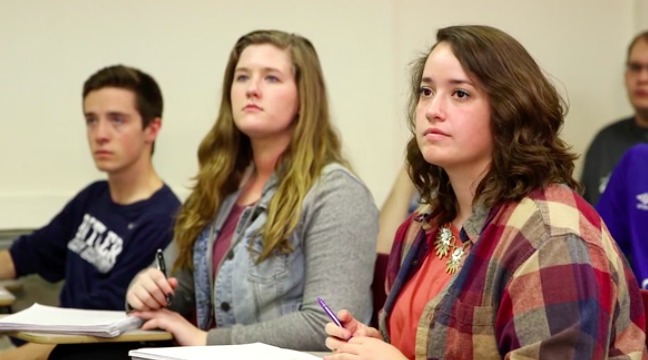
News Roundup: Teachable Moments and Collaboration
This week, instructors discuss turning mistakes into teachable moments and collaboration in the classroom.
| Sign up for The Q Newsletter for weekly news and insights. |
Building Classroom Dialogue Using Webb’s Depth of Knowledge
Webb’s Depth of Knowledge, a model that categorizes tasks by the complexity of the type of thinking required to complete them, can facilitate meaningful conversations in the classroom, according to Andrew Miller. He explains how using Webb’s model can help instructors scaffold questions, leading students to a deeper understanding of course material. (UConn)
On Failure and Fear in the Classroom
The risk of failure goes hand in hand with a commitment to developing innovative teaching methods, writes Matthew Vickless. Instead of fearing these fumbles, he writes, instructors should turn them into teachable moments. (Center for Teaching Excellence at Central Penn College)
Getting Students Excited About Literature
Collaboration is the cornerstone of John Zubizarreta’s teaching. The English professor uses “reflective learning moments” to push students to consider how they learn and provides online forums for students to share ideas and reflections. (The Chronicle of Higher Education – Paywall)
Yes, You Have Implicit Biases, Too
Everyone has implicit biases, David Gooblar writes, but refusing to acknowledge them prevents instructors from actively working to counter these notions. Instead, Gooblar advocates that faculty consciously make the effort to challenge their own stereotypes and incorporate diverse perspectives into assignments and activities. (Vitae)
Partner News
Gorden Gee, West Virginia University: For higher ed to survive, we’ve got to ‘blow up the box’ (Education Dive)
University of Southern Mississippi: Entrepreneurs Turn to Mississippi Public Universities for Assistance (Southern Miss Now)
TiHE Podcast Meets ACUE’s Expert Dive
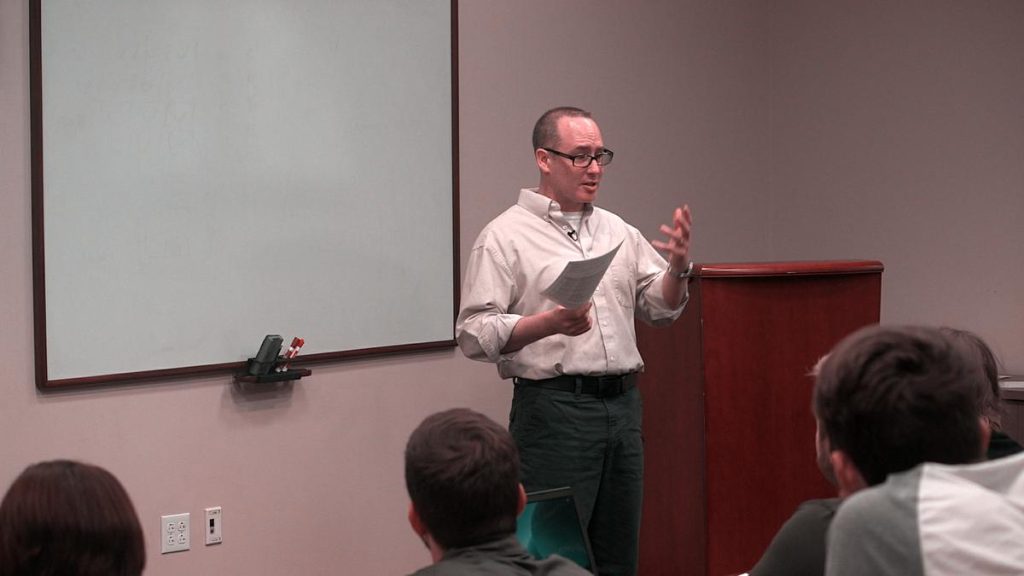
News Roundup: Sharing Stories, Foundational Skills
This week, ideas for providing students with forums to make their voices heard and addressing the work force skills gap by teaching foundational skills in college.
| Sign up for The Q Newsletter for weekly news and insights. |
Sharing Their Stories
In response to a student’s question about how to create a safe atmosphere for discussing controversial issues online, Bonni Stachowiak stresses the importance of prompting these dialogues, trusting and respecting students, and sharing their stories to make their voices heard. (Teaching in Higher Ed)
The Midsemester Course Correction
“Rigidity keeps us from giving every student—no matter their limitations—a chance to succeed,” writes David Gooblar. He urges faculty to be flexible with their courses, adapt to different situations, and use student data and input to alter plans when the need arises. (Vitae)
Getting Students Back and on Track
An emerging trend among colleges is reinstatement programs that give dismissed students a second chance. For example, at Eastern Illinois University, faculty help reinstated students with study skills, time management, goal setting, motivation and self-responsibility, and campus involvement. (University Business)
Solving the Work Force’s Skills Gap
Kimberly Cassidy and Gina Siesing encourage higher education institutions to address the work force’s skills gap by emphasizing foundational skills—critical thinking, collaboration, communication, creativity, and in particular, digital fluency—across all curricula, suggesting that these skills lead to long-term success. (Inside Higher Ed)
How One Master Educator Makes Dracula a Must-Take Course
Entertaining students is the key to keeping them engaged, according to Stanley Stepanic. In his popular Dracula course at the University of Virginia, Stepanic uses visuals, including movie posters and film clips, to teach students about human history through the lens of vampire folklore. (EdSurge)
Rethinking Educational Access
Arthur Levine advocates reconceptualizing higher education to provide students with lifelong learning opportunities to address a fast-changing employment landscape and inevitable career disruptions. Education powers an emerging economy, he opines. (Inside Higher Ed)
Partner News
José Bowen: Teaching Naked Techniques: Leveraging Research on Learning to Improve the Effectiveness of Teaching (Change Magazine)
University of Nevada, Reno: The Upward Bound Programs celebrate 50 years at the University of Nevada, Reno (Nevada Today)

Active Learning in STEM Courses
Change Magazine: “ACUE makes the link.”
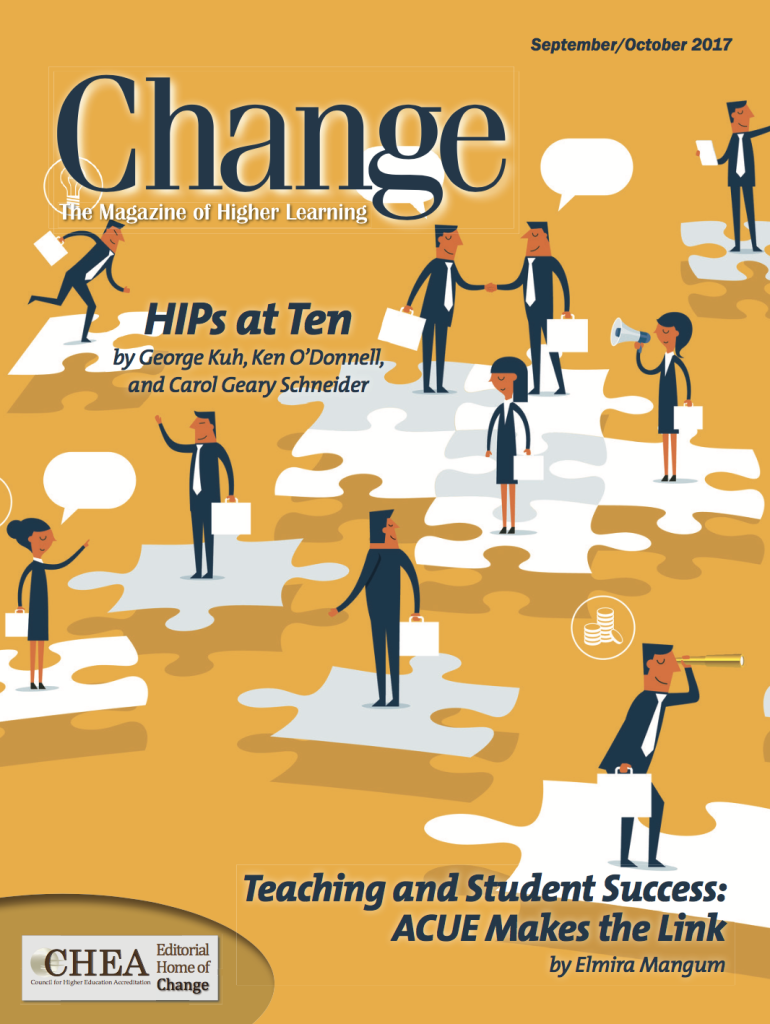
Change Magazine: “ACUE Makes the Link”
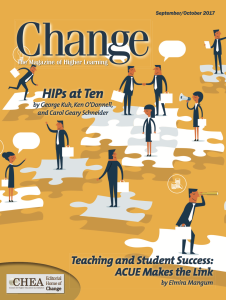 Teaching takes center stage in this fall’s issue of Change: The Magazine of Higher Learning, and ACUE is honored to share the spotlight. Alongside articles by George Kuh, Ken O’Donnell, and Carol Geary Schneider on high-impact practices, José Antonio Bowen and C. Edward Watson on the learning sciences, and Emily R. Miller and colleagues on the AAU STEM Initiative, ACUE’s work is featured in the cover story: “Teaching and Student Success: ACUE Makes the Link.” This collection of 13 short essays, with an introduction by Elmira Mangum, shares the diverse perspectives of students, faculty, administrators, and other stakeholders with whom we’ve developed a resource truly “of, by, and for” higher education.
Teaching takes center stage in this fall’s issue of Change: The Magazine of Higher Learning, and ACUE is honored to share the spotlight. Alongside articles by George Kuh, Ken O’Donnell, and Carol Geary Schneider on high-impact practices, José Antonio Bowen and C. Edward Watson on the learning sciences, and Emily R. Miller and colleagues on the AAU STEM Initiative, ACUE’s work is featured in the cover story: “Teaching and Student Success: ACUE Makes the Link.” This collection of 13 short essays, with an introduction by Elmira Mangum, shares the diverse perspectives of students, faculty, administrators, and other stakeholders with whom we’ve developed a resource truly “of, by, and for” higher education.
In his editorial, Change’s David Paris notes:
“It is a (too) common observation that faculty members’ training and expertise focus on their subject matter and research rather than pedagogy. What training they might receive concerning pedagogy depends on their graduate institution rather than reflecting widely shared professional standards. . . .
“As we reflect on our increased knowledge about teaching and related initiatives supporting faculty development, we might be tempted to think that we can make progress—and that perhaps such progress is already being made. Unfortunately, much of the evidence suggests that what we know is not being put broadly and effectively into practice. Graduation and retention rates are moving up slowly, if at all. . . .
“The gaps are especially troubling as we anticipate underrepresented students becoming a larger proportion of the student population. The data here is also distressing, ‘states with high percentages of underrepresented minorities and large attainment gaps are in a particularly dire situation.’ . . .
“But why is progress so slow? Why are we not doing what common sense and evidence suggest we do to improve professional practice, to get better? There are many factors, and part of the answer is suggested by . . . the need for training that the ACUE initiative seeks to address.”
Among the essays,
- Miami Dade College President Eduardo Padrón shares how great teaching—a long-sought priority of higher education—is within our grasp;
- Molly Corbett Broad explains how ACE’s quality assurance process helped to ensure that our program is comprehensive, evidence based, and of the highest quality;
- Linda Nilson, author of Teaching at Its Best: A Research-Based Resource for College Instructors, speaks to the learning design and scalability of our program;
- Catherine Haras, senior director of the Center for Effective Teaching and Learning at California State University, Los Angeles, discusses how evidence-based teaching practices are applicable to any field and how our program is expanding the center’s impact;
- Daniel Julius, senior vice president and provost at New Jersey City University, explores the positive financial implications of quality teaching;
- Vice President of Ewing Marion Kauffman Aaron North explains how quality instruction advances the Foundation’s commitment to college access;
- Kevin P. Reilly, president emeritus of the University of Wisconsin System, argues that trustees have a role to play in promoting instructional excellence;
- Amy Chasteen, professor and vice provost for academic affairs, describes how our program is bridging the gap between faculty and students, connecting faculty across disciplines, and resulting in dramatic payoffs in student success and faculty satisfaction;
- Mary E. Brown, a professor at Southern Connecticut State University, shares how valuable our course has been to refining her practice and recommends that all faculty complete the course;
- Bonita Veysey, vice chancellor for planning and implementation at Rutgers University–Newark, discusses why ACUE is written into the University’s strategic plan and reflects on how the course transformed her sense of her own teaching;
- Deborah Hecht, director and senior research scientist at the Center for Advanced Study in Education (CASE) at the CUNY Graduate Center, presents some of the early evidence on ACUE’s impact; and
- José Bowen, president of Goucher College, defines the essential role teaching plays in preparing a student for lifelong success and how a ‘degree’ in pedagogy can help faculty change lives.
These essays, taken together, make a powerful case for putting great teaching at the heart of our national student success agenda.
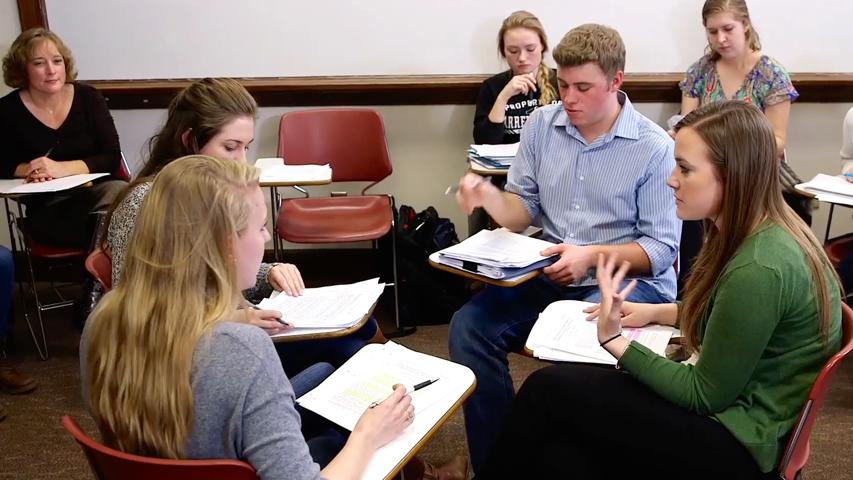
News Roundup: Innovative Teaching
This week, read about how 10 instructors are using innovative methods to teach their students.
| Sign up for The Q Newsletter for weekly news and insights. |
When Teaching Large Classes, Don’t Try to Put on a Show
Rachel Davenport believes teaching should be a collaboration with students, not a performance. In this podcast, she discusses embracing her awkwardness in the classroom, why she appreciates students stumping her with questions, and tools she uses to enhance her teaching. (EdSurge)
The Kids Are Still Alright
Rather than gripe about students, Rob Jenkins suggests instructors seek to better understand new generations and the pressures they face. He cites recognizing their many positive qualities and finding common ground as keys to relating to students. (Vitae)
Innovators: 10 Classroom Trailblazers
The Chronicle features 10 instructors who teach outside the box, including a professor who shares feedback on her students’ assignments in a videorecording and a lecturer who pairs students with adults with disabilities to create short films about the adults’ lives. (The Chronicle of Higher Education — Paywall)
Against Shortcuts and in Favor of Potholes
Instead of outlining a prescribed set of rules for budding writers, John Warner advocates urging students to experiment outside the boundaries of a template or rubric and find solutions to their own problems, a method he believes encourages deeper learning and student growth. (Just Visiting)
Partner News
University of Southern Mississippi: USM Launches Learning Assistants Program to Aid in Student Success (Southern Miss Now)
West Virginia University: West Virginia University President E. Gordon Gee Pushing ‘West Virginia Forward’ (The Intelligencer)
University of Nevada, Reno: 19 new programs join University academics (Nevada Today)
3 Myths About Active Learning

Three Misconceptions About Using Active Learning in STEM
Editor’s note: This post is written by Paul Blowers, a chemical and environmental engineering professor at the University of Arizona, who is featured in the module, Using Active Learning Techniques in Large Classes.
The first time I turned to active learning in my chemical engineering class was nearly 19 years ago. After two years of trying to teach the psychrometric chart, I realized that explaining a multidimensional plot of what seemed like random things on random axes to students wasn’t working. So in my third year, I flipped the activity and started at the end. Instead of explaining the axes of the chart, I simply asked students how many axes there were. I got numbers that ranged from 1 to 20. Students stayed engaged as I revealed one axis after another, and they began to learn how to approach deciphering a new figure.
This first attempt at integrating active learning in my class was a success. I was extremely pleased with myself. I thought I was nailing what “active learning” was and helping students learn. Yet while that particular lesson worked in that particular context, my application of that lesson led me astray and caused frustration for my students during subsequent lessons. Based on my confidence with my one experience with active learning, I thought I could apply that same method over and over again.
Thus, my experience with active learning has been iterative and ongoing. Like many STEM instructors, I was forced to work through a number of misconceptions about active learning in real time, noting my successes and adjusting when necessary. Here I share some of the top misconceptions and how I addressed them in my STEM classes.
Misconception #1 – Large class sizes stand in the way of student engagement.
The thought of implementing active learning techniques in large classes can be daunting. But in reality, active learning is quite freeing when you’re facing dozens, if not hundreds, of students. Stepping away from a lecture-style format allows the flexibility to incorporate more group work, and group work is a great way to engage students. When students are working through intense problems with their peers, we can circulate, listen to conversations, and adjust the content we present in real time based on students’ thinking and questions. Additionally, students are given an opportunity to work through problems within a supportive community of peers, which leads to greater success outside of class as well. With the help of learning assistants, students’ challenges and questions can be addressed immediately and we can be nimble enough to revise the active learning process during class.
Misconception #2 – Technology is a distraction in STEM classes.
The instruction “put your phones and laptops away” is a mainstay in many STEM classrooms. However, I have found that technology can be a great ally in achieving and maintaining engagement in class. During my classes, students use cell phones to snap pictures of their work, laptops to view videos of previously recorded lessons or dig into supplemental resources online, and Dropbox to submit their work at the end of the session for me and the teaching assistants to review. Students are already comfortable integrating technology into their daily lives, so why not work with it in class?
Misconception #3 – Students bring to my class sufficient foundational knowledge from prerequisite classes.
The reality that students may not absorb as much foundational knowledge as we expect is why formative assessment is particularly important in STEM disciplines. The thing I got right in my first active learning activity with the psychometric chart was an organic form of formative assessment. Instead of explaining concept after concept, this formative assessment allowed me to meet the students where they already were—in terms of knowledge base—and work backward to guide them to a more advanced understanding of the concept. This made it quite apparent that their foundational knowledge of the material was far from what I expected, as they didn’t even know the key terms I was using, like relative humidity and dry bulb temperature, or how to find an axis. Active learning allowed me to organically reach a level of formative assessment that resulted in a more realistic understanding of what the students already knew.
I also quickly realized that initial assessment isn’t enough and foundational information needs to be accounted for on a rolling basis. Just because students get something right once, it doesn’t mean we stop reinforcing foundational concepts. That’s why I use a technique called backfilling. Backfilling, which is my own term, is the process of asking a big, complex question that perhaps only 10% of students will answer successfully. These are the questions that are really only obvious to us content masters who have worked with our material for years. Across STEM, these questions might be “Is this a chemical phenomena or a physical one?” (chemistry), “Does gravity matter more or geometry?” (physics), or “Is this something you do with numbers or with variables?” (mathematics).
After asking the bigger question, I pose lower level questions, slowly building a more comprehensive view of how students can approach the larger question. I don’t only ask these foundational questions during one class period, but I repeat them over multiple class sessions to ensure student understanding. I argue that no question is too low level. Many of us make the mistake of dismissing certain questions as being “too easy” for our students, but that’s an assumption that we make at our students’ peril. Backfilling, or posing the foundational questions that lead to bigger ideas and reinforcing these introductory concepts throughout the term, allows all students to build confidence with the material and allows instructors to model a process for how experts tackle challenging questions.
If at first you don’t succeed…
The quick success with my first active learning activity followed by the quick failure when trying to apply that same concept again made me realize why STEM instructors are particularly poised for long-term success with active learning: because we are awesome at iteration. Our key to success is that we’re comfortable with mistakes. If we mess up once, maybe we mess up a little less the next time, and then we might just have some successes in the end.
Working through these misconceptions helped form the bedrock for the active learning techniques I use in my STEM classes today. Utilizing organic formative assessment in my classroom all those years ago allowed me to see that students were missing the foundational knowledge that I had been skipping over. Once I learned that, I was able to help students build a solid foundation in chemical engineering, refocusing the more advanced students on details they assumed or missed and keeping the struggling students on pace to learn the content fully. Success was not immediate, for me or the students, but a growth mindset on all accounts allowed us to progress. And now, in that same class, I experience a 90% to 95% retention rate, which is leagues above the national average of 50% to 60%. All thanks to active learning.
